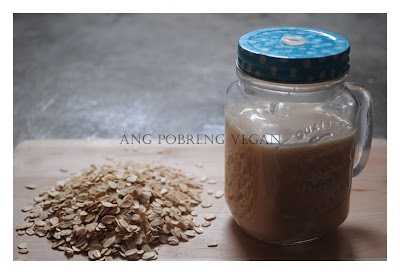Being a pobreng (poor) vegan that I am, I decided to make my own cheaper version of vegan milk. There are many cheaper alternatives to vegan nut milk but let me start with this oat milk recipe as I have already tried it. The others like brown rice milk, soy milk and bean milk, I haven’t tried yet. I might try brown rice milk but I doubt that I will post any recipes for soy milk. I am avoiding unfermented soy products because of phytoestrogen, which can worsen my condition.
As expected, oat milk tastes like, well, oats. But if you have been drinking commercial oat milk like the ones you see in the grocery shelves, then this recipe will give you the same results – albeit this version is healthier and cleaner because it does not contain any preservatives and artificial coloring. You can also make this version sugar-free if you want. Drinking oat milk has many nutritional benefits. Oats contain adequate amounts of protein like cow’s milk. It also contains 36% of the recommended daily allowance for calcium compared to whole milk which only contains 28%.
Homemade oat milk is very easy to make and it does not require any special ingredients and kitchen tools. You only need oats, water, salt, and sweetener. Moreover, you only need a blender and a sieve to turn oats into milk.
------------------------------------------------------------
Cuisine: Vegan, Sugar-Free
Serving size: 6
Serving size: 6
Preparation time: 20 minutes
Cooking time: 10 minutes
------------------------------------------------------------
Ingredients:
 1 cup oats (steel-cut or rolled oats)
1 cup oats (steel-cut or rolled oats)
3 cups water
1/2 cup coconut sugar
1/4 teaspoon salt
1 teaspoon vanilla (optional)
 1 cup oats (steel-cut or rolled oats)
1 cup oats (steel-cut or rolled oats)3 cups water
1/2 cup coconut sugar
1/4 teaspoon salt
1 teaspoon vanilla (optional)
Instructions:
- Place the steel-cut oats in a skillet over low flame and toast it for five minutes or until slightly brown.
- Transfer the toasted oats in a blender and add the rest of the ingredients.
- Blend until well combined and after the oats have been pulsed into tiny pieces.
- Pass through a sieve lined with a clean cloth to separate the oats from the liquid.
- This may take a few minutes. Run a spoon along the sieve to help facilitate the liquid to pass through the sieve.
- Adjust the sweetness.
- Serve chilled.
The best thing about making oat milk is tat you don't necessarily need to strictly follow the steps nor ingredients. The thing is that you can use the recipe to make other types of non-dairy "milk". Once you are finished with straining the oats, you will end up with a mash. Do not throw it away as you can use it to make vegan cookies and cakes.
There are many versions on how to make oat milk and this happens to be mine. I prefer to toast my oats as it imparts a nutty flavor to the oat milk. The oat milk will keep for a few days in the fridge but since it is so good chilled, mine only lasted for a few hours. Enjoy!
Ang Pobreng Vegan































